Apple A1455 Tablet Device User Manual iPad User Guide
Apple Inc. Tablet Device iPad User Guide
Apple >
Contents
User Manual 1 of 8

iPad
User Guide
For iOS Software
Draft
Apple Confidential
X.X
Contents
9 Chapter 1: At a Glance
9 Overview
10 Buttons
12 Micro-SIM card tray
12 Home screen
16 Using the Multi-Touch screen
18 Chapter 2: Getting Started
18 What you need
18 Setting up iPad
18 Setting up mail and other accounts
19 Managing content on iPad
19 Using iCloud
20 Syncing with iTunes
21 Connecting iPad to your computer
21 Viewing the user guide on iPad
22 Battery
23 Using and cleaning iPad
24 Chapter 3: Basics
24 Using apps
26 Customizing the Home screen
28 Typing
32 Searching
33 Printing
34 File Sharing
35 Notications
36 Twitter
37 Using AirPlay
37 Using Bluetooth devices
38 Security features
40 Chapter 4: Safari
40 Viewing webpages
41 Links
41 Reading List
41 Reader
41 Entering text and lling out forms
42 Searching
42 Bookmarks and history
42 Printing webpages, PDFs, and other documents
42 Web clips
2
Draft
Apple Confidential
43 Chapter 5: Mail
43 Checking and reading email
44 Working with multiple accounts
44 Sending mail
45 Using links and detected data
45 Viewing attachments
45 Printing messages and attachments
46 Organizing mail
46 Searching mail
46 Mail accounts and settings
48 Chapter 6: Messages
48 Sending and receiving messages
49 Sending messages to a group
49 Sending photos, videos, and more
50 Editing conversations
50 Searching messages
51 Chapter 7: Camera
51 About Camera
52 Taking photos and videos
52 Viewing, sharing, and printing
53 Editing photos
53 Trimming videos
53 Uploading photos and videos to your computer
54 Photo Stream
55 Chapter 8: FaceTime
55 About FaceTime
56 Making a FaceTime call
56 While on a FaceTime call
57 Chapter 9: Photo Booth
57 About Photo Booth
57 Selecting an eect
58 Taking a photo
58 Viewing and sharing photos
58 Uploading photos to your computer
59 Chapter 10: Photos
59 Viewing photos and videos
60 Viewing slideshows
60 Organizing photos and videos
61 Sharing photos and videos
61 Printing photos
61 Using Picture Frame
62 Importing photos and videos
63 Chapter 11 : Videos
63 About Videos
63 Playing videos
64 Watching rented movies
3
Contents
Draft
Apple Confidential
64 Watching videos on a TV
65 Deleting videos from iPad
65 Using Home Sharing
66 Chapter 12: YouTube
66 About YouTube
66 Browsing and searching for videos
67 Playing videos
68 Keeping track of videos you like
68 Sharing videos, comments, and ratings
68 Watching YouTube on a TV
69 Chapter 13: Calendar
69 About Calendar
69 Viewing your calendars
70 Adding events
70 Responding to invitations
71 Searching calendars
71 Subscribing to calendars
71 Importing calendar events from Mail
71 Syncing calendars
72 Calendar accounts and settings
73 Chapter 14: Contacts
73 About Contacts
73 Syncing contacts
74 Searching contacts
74 Adding and editing contacts
75 Contacts accounts and settings
76 Chapter 15: Notes
76 About Notes
76 Writing and reading notes
77 Searching notes
77 Printing or emailing notes
78 Chapter 16: Reminders
78 About Reminders
79 Setting a reminder
79 Managing reminders in list view
79 Managing reminders in date view
80 Managing completed reminders
80 Searching reminders
81 Chapter 17: Maps
81 Finding locations
82 Getting directions
83 Getting and sharing info about a location
83 Showing trac conditions
84 Map views
4Contents
Draft
Apple Confidential
85 Chapter 18: Music
85 Adding music and audio
85 Playing songs and other audio
87 Viewing tracks on an album
87 Searching audio content
87 iTunes Match
88 Genius
88 Playlists
89 Home Sharing
90 Chapter 19: iTunes Store
90 About the iTunes Store
90 Finding music, videos, and more
91 Purchasing music, audiobooks, and tones
91 Purchasing or renting videos
91 Following artists and friends
92 Streaming or downloading podcasts
92 Checking download status
92 Viewing account information
93 Verifying downloads
94 Chapter 20: App Store
94 About the App Store
95 Finding and downloading apps
95 Deleting apps
96 Store settings
97 Chapter 21: Newsstand
97 About Newsstand
98 Reading the latest issues
99 Chapter 22: iBooks
99 About iBooks
99 Using the iBookstore
100 Syncing books and PDFs
100 Reading books
102 Changing a book’s appearance
102 Studying notes and vocabulary lists
102 Interacting with multimedia
103 Printing or emailing a PDF
103 Organizing the bookshelf
104 Chapter 23: Game Center
104 About Game Center
105 Signing in to Game Center
105 Purchasing and downloading games
105 Playing games
105 Playing with friends
106 Game Center settings
5
Contents
Draft
Apple Confidential
107 Chapter 24: Accessibility
107 Universal Access features
107 About VoiceOver
116 Triple-click Home
117 Zoom
117 Large Text
117 White on Black
117 Speak Selection
118 Speak Auto-Text
118 Mono Audio
118 AssistiveTouch
119 Universal Access in OS X
119 Minimum font size for mail messages
119 Widescreen keyboards
119 Closed captioning
120 Chapter 25: Settings
120 Airplane Mode
120 Wi-Fi
121 Notications
122 Location Services
122 Cellular Data
123 VPN
123 Personal Hotspot
123 Brightness & Wallpaper
124 Picture Frame
124 General
129 Settings for apps
130 Appendix A: iPad in Business
130 iPad in the enterprise
130 Using conguration proles
130 Setting up Microsoft Exchange accounts
131 VPN access
131 LDAP and CardDAV accounts
132 Appendix B: International Keyboards
132 Adding and removing keyboards
132 Switching keyboards
132 Chinese
134 Japanese
134 Typing emoji characters
134 Using the candidate list
134 Using shortcuts
135 Vietnamese
136 Appendix C: Support and Other Information
136 iPad Support site
136 Low-battery image or “Not Charging” message appears
136 iPad doesn’t respond
137 Restarting and resetting iPad
137 “This accessory is not supported by iPad” appears
6Contents
Draft
Apple Confidential
137 An app doesn’t ll the screen
137 Onscreen keyboard doesn’t appear
137 Backing up iPad
139 Updating and restoring iPad software
139 Can’t send or receive email
140 Sound, music, and video
141 iTunes Store and App Store
142 Safety, service, and support information
142 Disposal and recycling information
142 Apple and the environment
143 iPad operating temperature
7
Contents
Draft
Apple Confidential
Draft
Apple Confidential
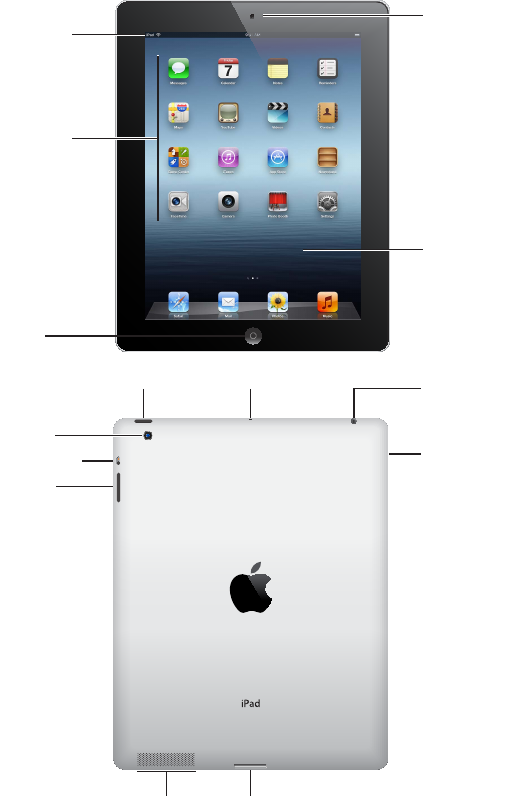
At a Glance 1
Read this chapter to learn about iPad features, how to use the controls, and more.
Overview
Multi-Touch
display
Multi-Touch
display
Front
camera
Front
camera
Home
Home
App icons
App icons
Status bar
Status bar
Dock connector
Dock connector
Speaker
Speaker
Microphone
Microphone
Headphone
jack
Headphone
jack
Micro-SIM
tray (on some
models)
Micro-SIM
tray (on some
models)
Sleep/Wake
Sleep/Wake
Back
camera
Back
camera
Volume
buttons
Volume
buttons
Side Switch
Side Switch
Your iPad features and the Home screen may be dierent, depending on the model of iPad you have.
9
Draft
Apple Confidential
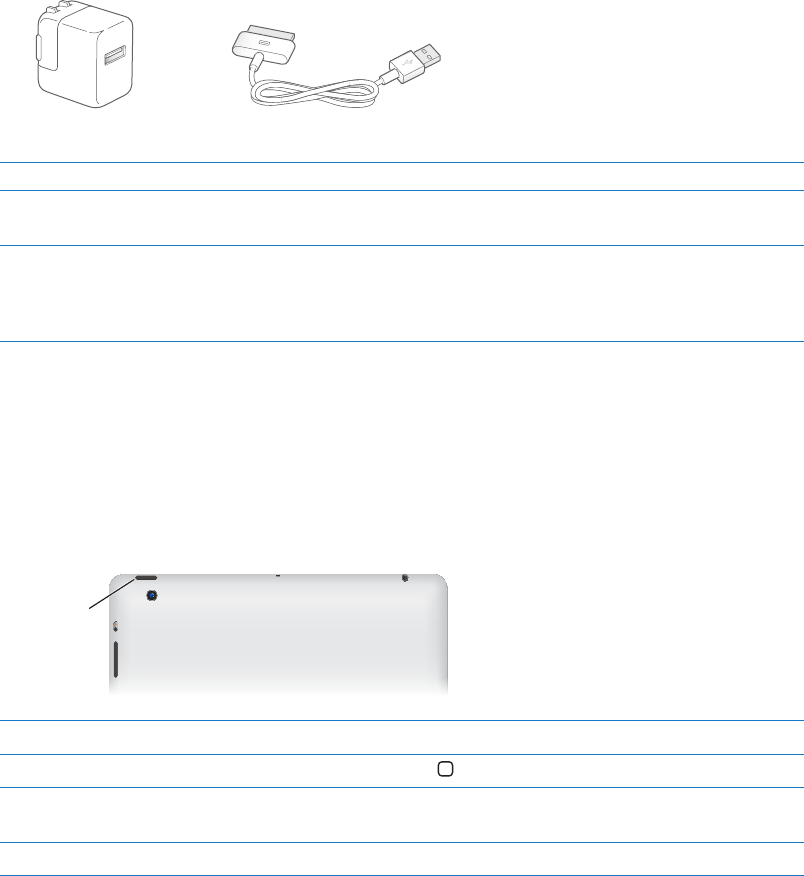
Accessories
The following accessories are included with iPad:
Dock Connector to USB Cable
Dock Connector to USB CableDock Connector to USB Cable
10W USB Power Adapter
10W USB Power Adapter10W USB Power Adapter
Item What you can do with it
10W USB power adapter Use the 10W USB power adapter to provide power to
iPad and charge the battery.
Dock Connector to USB Cable Use this cable to connect iPad to the 10W USB power
adapter to charge or to your computer to sync. Use the
cable with the optional iPad Dock, or plug it directly
into iPad.
Buttons
A few buttons make it easy to lock iPad and adjust the volume.
Sleep/Wake button
You can lock iPad by putting it to sleep when you’re not using it. When you lock iPad, nothing
happens if you touch the screen, but music continues playing and you can use the volume buttons.
Sleep/Wake
button
Sleep/Wake
button
Lock iPad Press the Sleep/Wake button.
Unlock iPad Press the Home button or the Sleep/Wake button, then drag the slider.
Turn iPad o Hold down the Sleep/Wake button for a few seconds until the red slider
appears, then drag the onscreen slider.
Turn iPad on Hold down the Sleep/Wake button until the Apple logo appears.
If you don’t touch the screen for a minute or two, iPad locks automatically. You can change how
long it takes the screen to lock, or set a passcode to unlock iPad.
Set the Auto-Lock time: In Settings, go to General > Auto-Lock, then set a time for iPad to
lock automatically.
Set a passcode: In Settings, go to General > Passcode Lock, then tap On or O.
Use an iPad Smart Cover, sold separately, with iPad 2 or later to automatically unlock iPad when
you open the cover and lock iPad when you close it.
Use an iPad Smart Cover: In Settings, go to General > iPad Cover Lock/Unlock, then tap On.
10 Chapter 1 At a Glance
Draft
Apple Confidential
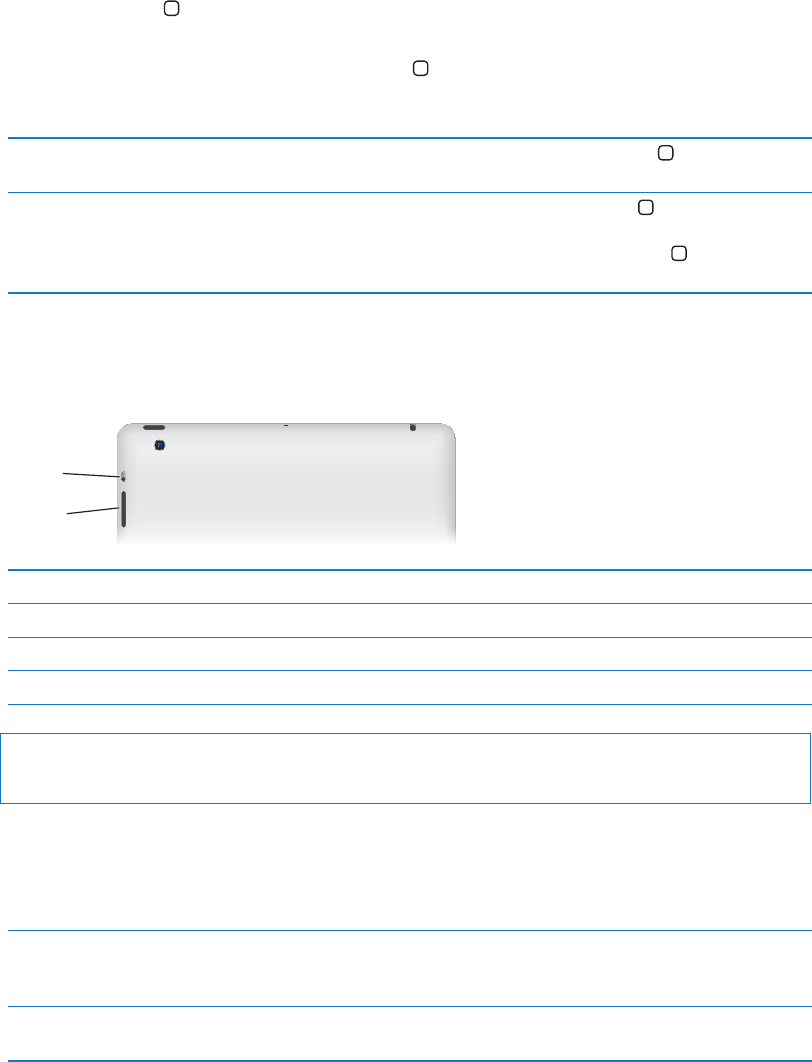
Home button
The Home button lets you get back to the Home screen at any time. It also provides other
convenient shortcuts.
Go to the Home screen: Press the Home button .
On the Home screen, tap an app to open it. See “Opening and switching apps” on page 24.
Display the multitasking bar to see
recently used apps
When iPad is unlocked, double-click the Home button .
Display audio playback controls When iPad is locked: Double-click the Home button . See “Playing songs
and other audio” on page 85.
When using another app: Double-click the Home button , then ick the
multitasking bar from left to right.
Volume buttons
Use the volume buttons to adjust the volume of songs and other media, and of alerts and
sound eects.
Volume
buttons
Volume
buttons
Side
Switch
Side
Switch
Increase the volume Press the Volume Up button.
Decrease the volume Press the Volume Down button.
Set a volume limit In Settings, go to Music > Volume Limit.
Mute the sound Hold down the Volume Down button.
WARNING: For important information about avoiding hearing loss, see the iPad Important
Product Information Guide at support.apple.com/manuals/ipad.
Side Switch
You can use the Side Switch to disable audio alerts and notications. You can also use it to lock the
screen rotation and prevent the iPad display from switching between portrait and landscape mode.
Mute notications, alerts, and
sound eects
Slide the Side Switch down to mute notications, alerts, and sound eects.
This switch doesn’t mute audio playback, such as music, podcasts, movies,
and TV shows. See “Side Switch” on page 12 7.
Lock the screen rotation In Settings, go to General > Use Side Switch to, then tap Lock Rotation. See
“Side Switch” on page 12 7.
11
Chapter 1 At a Glance
Draft
Apple Confidential
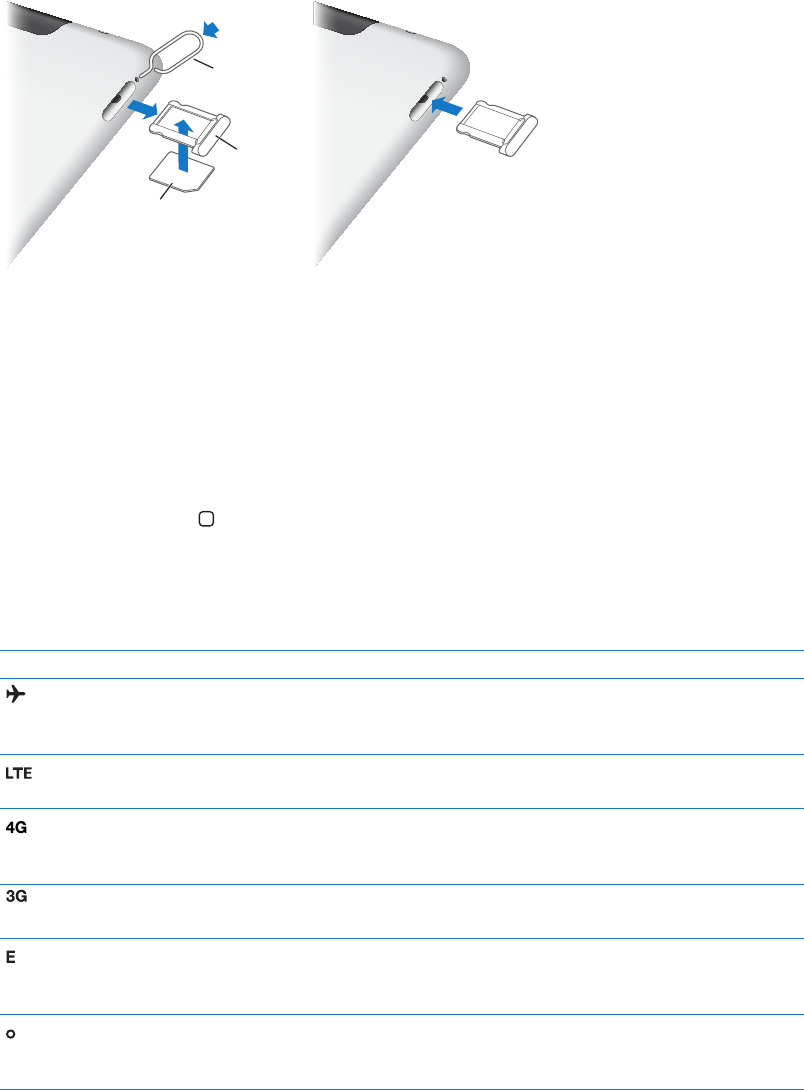
Micro-SIM card tray
The micro-SIM card in some 4G and 3G models is used for cellular data. If your micro-SIM card
wasn’t preinstalled or if you change cellular data carriers, you may need to install or replace the
micro-SIM card.
Micro-SIM
card
Micro-SIM
card
SIM
tray
SIM
tray
SIM eject
tool
SIM eject
tool
Open the SIM tray: Insert the tip of the SIM eject tool into the hole on the SIM tray. Press rmly
and push the tool straight in until the tray pops out. Pull out the SIM tray to install or replace
the micro-SIM card. If you don’t have a SIM eject tool, you may be able to use the end of a small
paper clip.
For more information, see “Cellular Data” on page 12 2 .
Home screen
Press the Home button at any time to go to the Home screen, which displays your iPad apps.
Tap any icon to open the app. See “Using apps” on page 24.
Status icons
The icons in the status bar at the top of the screen give information about iPad:
Status icon What it means
Airplane mode Shows that airplane mode is on—you can’t access the
Internet, or use Bluetooth® devices. Non-wireless features
are available. See “Airplane Mode” on page 120.
LTE Shows that your carrier’s 4G LTE network (iPad Wi-Fi + 4G) is
available, and you can connect to the Internet over 4G LTE.
4G Shows that your carrier’s 4G network (some iPad Wi-Fi + 4G
models) is available, and you can connect to the Internet
over 4G.
3G Shows that your carrier’s 3G network (4G or 3G models) is
available, and you can connect to the Internet over 3G.
EDGE Shows that your carrier’s EDGE network (some 4G or 3G
models) is available, and you can connect to the Internet
over EDGE.
GPRS Shows that your carrier’s GPRS network (some 4G or 3G
models) is available, and you can connect to the Internet
over GPRS.
12 Chapter 1 At a Glance
Draft
Apple Confidential
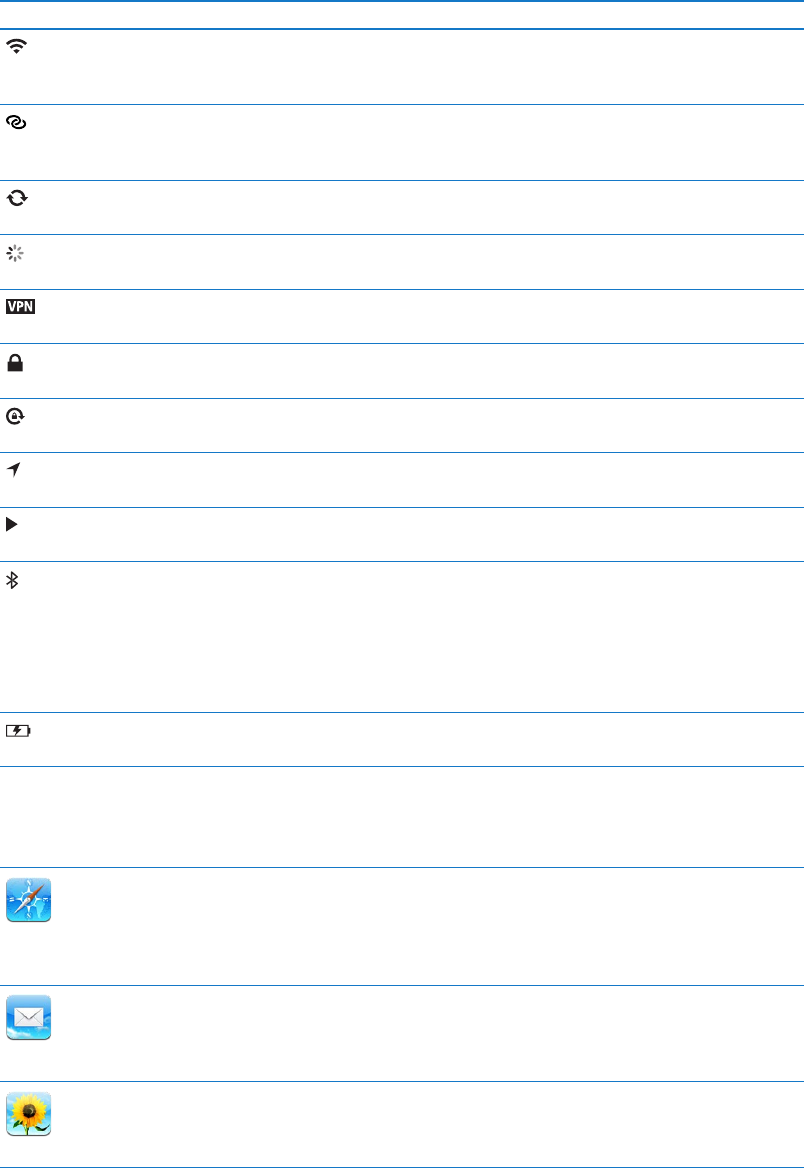
Status icon What it means
Wi-Fi Shows that iPad has a Wi-Fi Internet connection. The more
bars, the stronger the connection. See “Joining a Wi-Fi
network” on page 120.
Personal Hotspot Shows that iPad is providing a Personal Hotspot to
another iPad, iPhone, or iPod touch. See “Personal
Hotspot” on page 123.
Syncing Shows that iPad is syncing with iTunes. See “Syncing with
iTunes” on page 20.
Activity Shows network and other activity. Some third-party apps
use this icon to show an active process.
VPN Shows that you’re connected to a network using VPN. See
“VPN” on page 123.
Lock Shows that iPad is locked. See “Sleep/Wake button” on
page 10.
Screen orientation lock Shows that the screen orientation is locked. See “Viewing
in portrait or landscape” on page 15.
Location Services Shows that an item is using Location Services. See
“Location Services” on page 12 2 .
Play Shows that a song, audiobook, or podcast is playing. See
“Playing songs and other audio” on page 85.
Bluetooth White icon: Bluetooth is on and paired with a device, such
as a headset or keyboard.
Gray icon: Bluetooth is on and paired with a device, but
the device is out of range or turned o.
No icon: Bluetooth is turned o or not paired.
See “Using Bluetooth devices” on page 37.
Battery Shows the battery level or charging status. See “Charging
the battery” on page 22.
iPad apps
iPad comes with the following apps:
Safari
Browse websites on the Internet. Rotate iPad sideways for widescreen viewing. Double-tap to
zoom in or out—Safari automatically ts the webpage column to the screen. Open multiple
pages using tabs. Sync bookmarks with Safari or Microsoft Internet Explorer on your computer.
Add Safari web clips to the Home screen for fast access to favorite websites. Save images from
websites to your Photo Library. Print webpages using AirPrint. See Chapter 4, “ Safari,” on page 40.
Mail
Send and receive mail using many of the most popular mail services, Microsoft Exchange, or
most industry-standard POP3 and IMAP mail services. Send and save photos. View PDF les and
other attachments, or open them in other apps. Print messages and attachments using AirPrint.
See Chapter 5, “ Mail,” on page 43.
Photos
Organize your favorite photos and videos into albums. Watch a slideshow. Zoom in for a closer
look. Edit photos and print them using AirPrint. Use Photo Stream to push the photos you take
on iPad to your devices. See Chapter 10, “ Photos,” on page 59.
13
Chapter 1 At a Glance
Draft
Apple Confidential
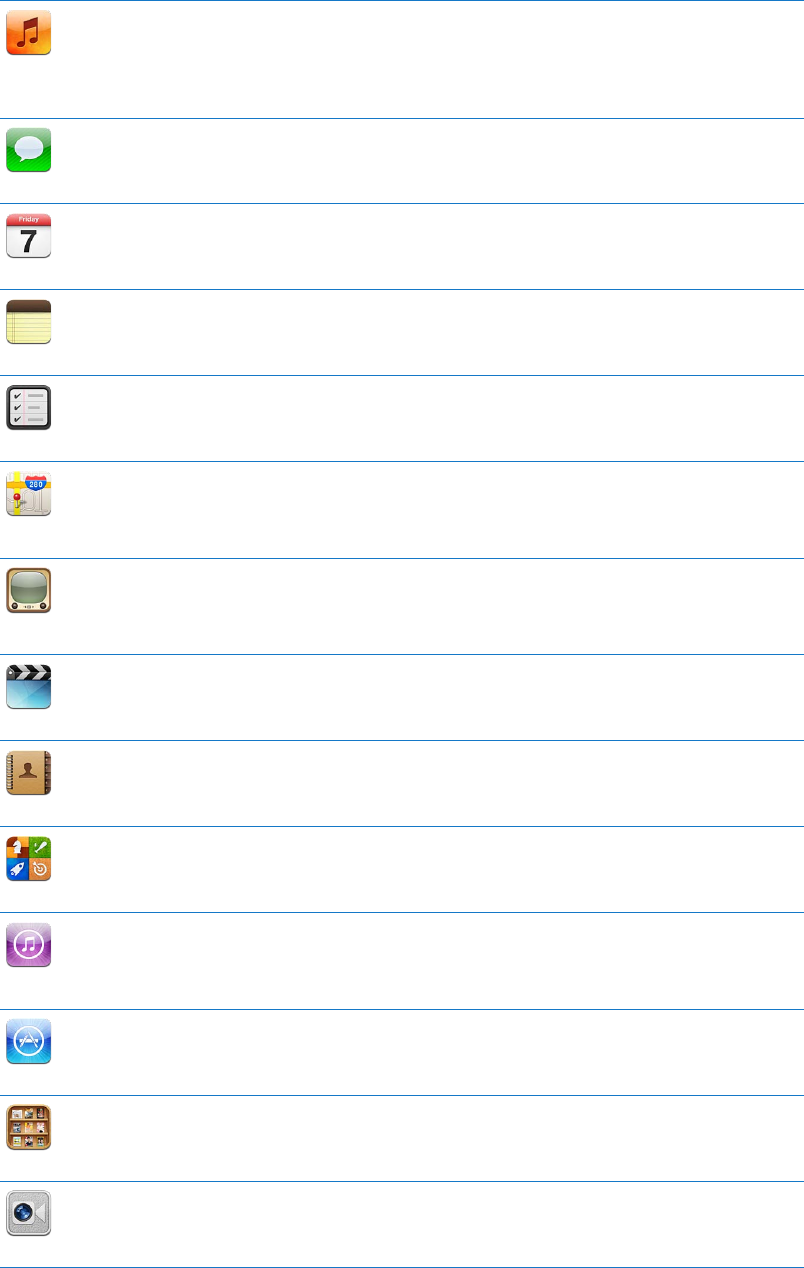
Music
Sync with your iTunes library and listen to your songs, audiobooks, and podcasts on iPad.
Create and manage playlists, or use Genius to create playlists for you. Listen to Genius Mixes
of songs from your library. Use Home Sharing to play music from your computer. Stream
your music or videos wirelessly to an Apple TV or compatible audio system using AirPlay. See
Chapter 18, “ Music,” on page 85.
Messages
Send messages over Wi-Fi to other iOS 5 users, and include photos, videos, and other
information. Your messages are encrypted. See Chapter 6, “Messages,” on page 48.
Calendar
Keep your calendar current on iPad, or sync it with your Mac OS X or Windows calendar.
Subscribe to others’ calendars. Sync over the Internet with Microsoft Exchange or CalDAV servers.
See Chapter 13, “Calendar,” on page 69.
Notes
Take notes on the go—grocery lists, brilliant ideas. Send them in mail. Sync notes to Mail or
Microsoft Outlook or Outlook Express. See Chapter 15, “Notes,” on page 76.
Reminders
Organize your life with due dates and lists. Reminders work with iCal and Microsoft Outlook on
your computer. You can keep your reminders up to date across all your devices using iCloud or a
Microsoft Exchange account. See Chapter 16, “ Reminders,” on page 78.
Maps
See a standard, satellite, hybrid, or terrain view of locations around the world. Zoom in for a
closer look, or check out Google Street View. Find your current location. Get detailed driving,
public transit, or walking directions and see current highway trac conditions. Find businesses
in the area. See Chapter 17, “Maps,” on page 81.
YouTube
Play videos from YouTube’s online collection. Search for any video, or browse featured,
most viewed, most recently updated, and top-rated videos. Set up and log in to your
YouTube account—then rate videos, sync your favorites, show subscriptions, and more. See
Chapter 12, “ YouTube,” on page 66.
Videos
Play movies, TV shows, podcasts, videos from your iTunes library or your movie collection.
Buy or rent movies on iPad using the iTunes Store. Download video podcasts. See
Chapter 11 , “ Videos,” on page 63.
Contacts
Organize your address book on iPad and keep it up to date on all of your iOS devices with
iCloud. See Chapter 14, “Contacts,” on page 73.
Game Center
Discover new games and share your game experiences with friends. Invite a friend, or request
a match with an opponent. Check player rankings on the leaderboards. Gain achievements for
extra points. See Chapter 23, “Game Center,” on page 104.
iTunes Store
Search the iTunes Store for music, audiobooks, TV shows, music videos, and movies. Browse,
preview, purchase, and download new releases, top items, and more. Buy or rent movies and buy
TV shows to view on iPad. Download podcasts. Read reviews, or write your own reviews for your
favorite store items. See Chapter 19, “iTunes Store,” on page 90.
App Store
Search the App Store for apps you can purchase or download. Read reviews, or write your
own reviews for your favorite apps. Download and install the apps on your Home screen. See
Chapter 20, “App Store,” on page 94.
Newsstand
Keep all your app subscriptions in one convenient place. Newsstand automatically downloads
whatever’s new for each of your app subscriptions. It all happens in the background, so you
never have to interrupt what you’re doing. See Chapter 21, “Newsstand,” on page 97.
FaceTime
Make video calls to other FaceTime users over Wi-Fi. Use the front camera to talk face to face, or
the back camera to share what you see. See Chapter 8, “FaceTime,” on page 55.
14 Chapter 1 At a Glance
Draft
Apple Confidential
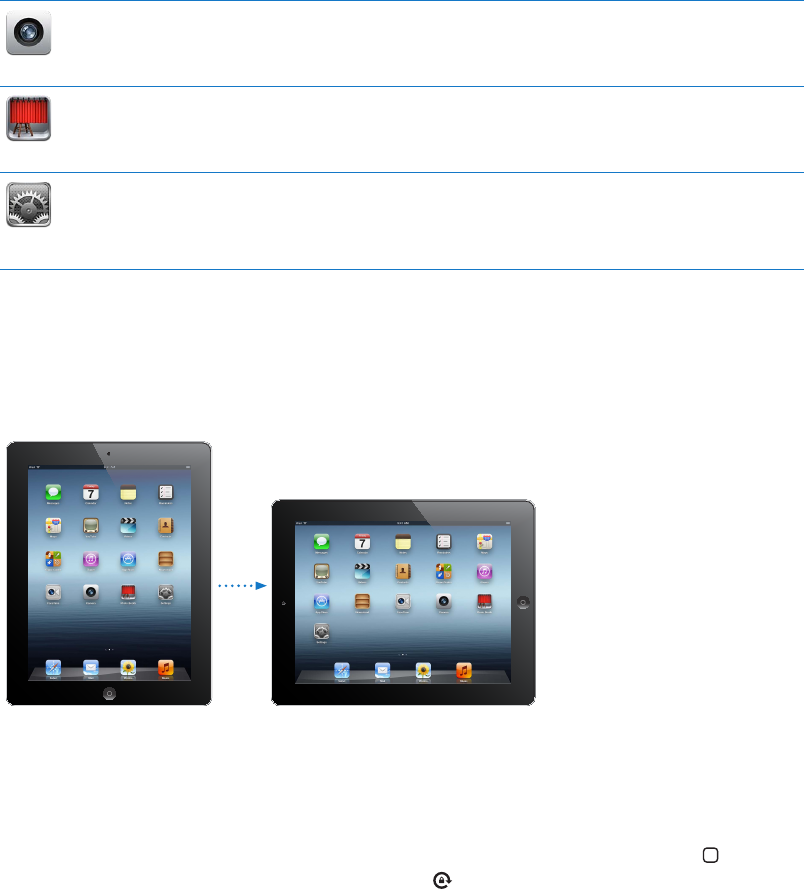
Camera
Take photos and record HD videos. View them on iPad, mail them, or upload them to your
computer or the Internet. Tap to set the exposure. Trim and save video clips. Upload videos
directly to YouTube. See Chapter 7, “Camera,” on page 51.
Photo Booth
Use the front or back camera to take a snapshot. Add a special eect, such as twirl or
stretch, before you take a snapshot. Snapshots are saved in an album in the Photo app. See
Chapter 9, “ Photo Booth,” on page 57.
Settings
Personalize your iPad settings in one convenient place—network, mail, web, music, video,
photos, and more. Set up Picture Frame, mail accounts, contacts, and calendars. Manage your
cellular data account. Set an auto-lock and a passcode for security. See Chapter 25, “Settings,” on
page 120.
Note: App functionality and availability may vary depending on where you purchase and use iPad.
Viewing in portrait or landscape
You can view iPad‘s built-in apps in either portrait or landscape orientation. Rotate iPad and the
screen rotates too, adjusting automatically to t the new orientation.
You may prefer landscape orientation for viewing webpages in Safari, for example, or when
entering text. Webpages automatically scale to the wider screen, making the text and images
larger. The onscreen keyboard also becomes larger, which may help increase your typing speed
and accuracy. Lock the screen orientation if you want to keep the screen from rotating.
Lock the screen in portrait or landscape orientation: Double-click the Home button to view
the multitasking bar, then ick from left to right. Tap to lock the screen orientation.
You can also set the Side Switch to lock the screen orientation instead of silencing sound eects
and notications. In Settings, go to General > Use Side Switch to, then tap Lock Rotation. See
“Side Switch” on page 127.
15
Chapter 1 At a Glance
Draft
Apple Confidential
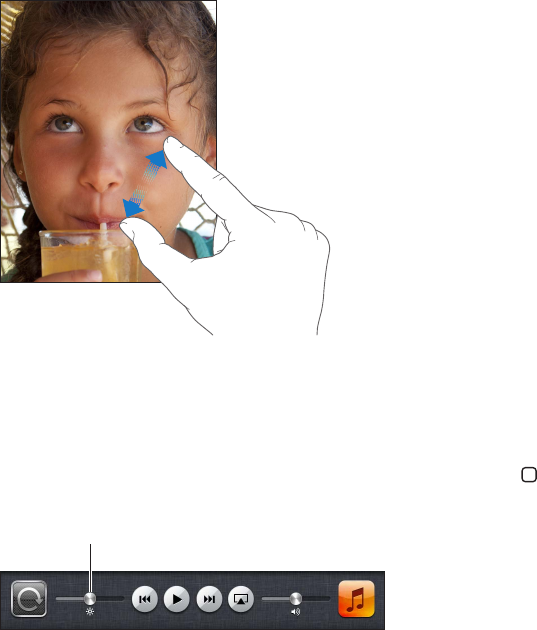
Using the Multi-Touch screen
The controls on the Multi-Touch screen change, depending on the task you’re performing. To
control iPad, use your ngers to pinch, swipe, tap, and double-tap.
Using multitasking gestures
You can use multitasking gestures on iPad to return to the home screen, reveal the multitasking
bar, or switch to another app.
Return to the Home screen: Pinch four or ve ngers together.
Reveal the multitasking bar: Swipe up with four or ve ngers.
Switch apps: Swipe left or right with four or ve ngers.
Turn multitasking gestures on or o: In Settings, go to > General > Multitasking Gestures, then
tap On or O.
Zooming in or out
While viewing photos, webpages, mail, or maps, you can zoom in and out. Pinch two ngers
together or apart. For photos and webpages, you can double-tap (tap twice quickly) to zoom
in, then double-tap again to zoom out. For maps, double-tap to zoom in and tap once with two
ngers to zoom out.
Zoom is also an accessibility feature that lets you magnify the entire screen of any app you’re
using and helps you see what’s on the display. See “Zoom” on page 117.
Adjusting brightness
To adjust the screen’s brightness, double-click the Home button to view the multitasking bar.
Flick from left to right, then drag the brightness slider.
Brightness
Brightness
Use Auto-Brightness to automatically adjust the screen’s brightness: In Settings, go to
Brightness & Wallpaper.
See “Brightness & Wallpaper” on page 123.
16 Chapter 1 At a Glance
Draft
Apple Confidential
Using the onscreen keyboard
The onscreen keyboard appears automatically anytime you need to type. Use the keyboard
to enter text, such as contact information, mail, and web addresses. The keyboard corrects
misspellings, predicts what you’re typing, and learns as you use it. See “Typing” on page 28.
Using lists
Some lists have an index along the side to help you navigate quickly.
Find items in an indexed list: Tap a letter to jump to items starting with that letter. Drag your
nger along the index to scroll quickly through the list.
Choose an item: Tap an item in the list.
Depending on the list, tapping an item can do dierent things—for example, it may open a new
list, play a song, open an mail message, or show someone’s contact information.
Return to a previous list: Tap the back button in the upper-left corner.
17
Chapter 1 At a Glance
Draft
Apple Confidential

Getting Started 2
Read this chapter to learn how to set up iPad, set up mail accounts, use iCloud, and more.
What you need
WARNING: To avoid injury, read all operating instructions in this guide and safety information in the
iPad Important Product Information Guide at support.apple.com/manuals/ipad before using iPad.
·
To use iPad, you need:
An Apple ID for some features, including iCloud, the App Store and iTunes Store, and Â
online purchases
An Internet connection (broadband is recommended) Â
To use iPad with your computer, you need:
A Mac or a PC with a USB 2.0 port and one of the following operating systems: Â
Mac OS X version 10.5.8 or later Â
Windows 7, Windows Vista, or Windows XP Home or Professional with Service Pack 3 or later Â
iTunes 10.6 or later, available at Âwww.itunes.com/download
Setting up iPad
To set up iPad, turn it on and follow the Setup Assistant. The onscreen directions in Setup
Assistant step you through the setup process, including connecting to a Wi-Fi network, signing in
with or creating a free Apple ID, setting up iCloud, and turning on recommended features, such as
Location Services and Find My iPad.
During setup, you can copy your apps, settings, and content from another iPad by restoring from
an iCloud backup or from iTunes. See “Backing up iPad” on page 137.
Setting up mail and other accounts
iPad works with iCloud, Microsoft Exchange, and many of the most popular Internet-based mail,
contacts, and calendar service providers.
If you don’t already have a mail account, you can set up a free iCloud account when you set up
iPad, or set one up later in Settings > iCloud. See “Using iCloud” on page 19.
Set up an iCloud account: Go to Settings > iCloud.
Set up another account: Go to Settings > Mail, Contacts, Calendars.
You can add contacts using an LDAP or CardDAV account, if your company or organization
supports it. See “Syncing contacts” on page 73.
For information about setting up a Microsoft Exchange account in a corporate environment, see
“Setting up Microsoft Exchange accounts” on page 130 .
18
Draft
Apple Confidential
Managing content on iPad
You can transfer information and les between iPad and your other iOS devices and computers,
using either iCloud or iTunes.
ÂiCloud stores content such as music, photos, and more, and wirelessly pushes it to your other
iOS devices and computers, keeping everything up to date. See “Using iCloud,” below.
ÂiTunes syncs music, video, photos, and more between your computer and iPad. Changes
you make on one device are copied to the other when you sync. You can also use iTunes to
copy a le to iPad for use with an app, or to copy a document you’ve created on iPad to your
computer. See “Syncing with iTunes” on page 20.
You can use iCloud or iTunes, or both, depending on your needs. For example, you can use iCloud
Photo Stream to automatically push photos you take on iPad to your other devices, and use
iTunes to sync photo albums from your computer to iPad.
Note: Don’t sync items in the Info pane of iTunes (such as contacts, calendars, and notes) and
also use iCloud to keep that information up to date on your devices. Otherwise, you may see
duplicated data on iPad.
Using iCloud
iCloud stores your content, including music, photos, contacts, calendars, and supported documents.
Content stored in iCloud is pushed wirelessly to your other iOS devices and computers set up with
the same iCloud account.
iCloud is available on iOS 5 devices, on Macs running OS X Lion v10.7.2 or later, and on PCs with
the iCloud Control Panel for Windows (Windows Vista Service Pack 2 or Windows 7 required).
iCloud features include:
ÂiTunes in the Cloud—Download previous iTunes music and TV show purchases to iPad for free,
anytime you like.
ÂApps and Books—Download previous App Store and iBookstore purchases for free, anytime
you like.
ÂPhoto Stream—Photos you take on one device appear automatically on all your devices. See
“Photo Stream” on page 54.
ÂDocuments in the Cloud—For iCloud-enabled apps, keep documents and app data up to date
across all your devices.
ÂMail, Contacts, Calendars—Keep your mail contacts, calendars, notes, and reminders up to date
across all your devices.
ÂBackup—Back up iPad to iCloud automatically when connected to power and Wi-Fi. See
“Backing up with iCloud” on page 137.
ÂFind My iPad—Locate your iPad on a map, display a message, play a sound, lock the screen, or
remotely wipe the data. See “Find My iPad” on page 38.
ÂFind My Friends—Keep track of your family and friends (when connected to a Wi-Fi or cellular
network) using the Find My Friends app. Download the free app from the App Store.
ÂiTunes Match—With an iTunes Match subscription, all your music, including music you’ve
imported from CDs or purchased somewhere other than iTunes, appears on all of your devices
and can be downloaded and played on demand. See “iTunes Match” on page 87.
With iCloud, you get a free mail account and 5 GB of storage for your mail, documents, and
backups. Your purchased music, apps, TV shows, and books, as well as your Photo Stream, don’t
count against your free space.
19
Chapter 2 Getting Started
Draft
Apple Confidential

Note: iCloud is not available in all areas, and iCloud features may vary by area. For information
about iCloud, go to www.apple.com/icloud.
Sign in or create an iCloud account: Go to Settings > iCloud.
If you have a MobileMe subscription, you can move it to iCloud from a Mac or PC at
www.me.com/move until June 30, 2012.
Enable or disable iCloud services Go to Settings > iCloud.
Enable iCloud backups Go to Settings > iCloud > Storage & Backup.
Find your iPad Visit www.icloud.com, sign in with your Apple ID, then choose Find My iPad.
Important: On your iPad, Find My iPad must be turned on in Settings >
iCloud in order for iPad to be located.
But more iCloud storage Go to Settings > iCloud > Storage & Backup, then tap Buy More Storage. For
information about buying iCloud storage, go to help.apple.com/icloud.
View and download previous
iTunes Store purchases
Go to the iTunes Store, then tap Purchased .
View and download previous
App Store purchases
Go to the App Store, then tap Purchased .
View and download previous
iBookstore purchases
Go to iBooks, tap Store, then tap Purchased .
Turn Photo Stream on or o Go to Settings > iCloud > Photo Stream.
Turn on Automatic Downloads
for music, apps, or books
Go to Settings > Store.
For more information about iCloud, go to www.apple.com/icloud. For support information, go to
www.apple.com/support/icloud.
Syncing with iTunes
Syncing with iTunes copies information from a computer to iPad, and vice versa. You can sync
by connecting iPad to your computer using the Dock Connector to USB Cable, or you can set up
iTunes to sync wirelessly using Wi-Fi. You can set iTunes to sync music, photos, video, podcasts,
apps, and more. For detailed information about syncing iPad with a computer, open iTunes then
select iTunes Help from the Help menu.
Set up wireless iTunes syncing: Connect iPad to your computer using the Dock Connector to
USB Cable. In iTunes, turn on “Sync over Wi-Fi connection” in the device’s Summary pane.
When Wi-Fi syncing is turned on, iPad automatically syncs every day. iPad must be connected to
a power source, both iPad and your computer must be on the same wireless network, and iTunes
must be open on the computer. For more information, see “iTunes Wi-Fi Sync.”
Tips for syncing with iTunes
If you’re using iCloud to store your contacts, calendars, bookmarks, and notes, don’t also sync Â
them to iPad using iTunes.
Purchases you make from the iTunes Store or the App Store on iPad are synced back to your Â
iTunes library. You can also purchase or download content and apps from the iTunes Store on
your computer, and then sync them to iPad.
In the device’s Summary pane, you can set iTunes to automatically sync iPad when it’s attached Â
to your computer. To temporarily override this, hold down Command and Option (Mac) or Shift
and Control (PC) until you see your iPad appear in the sidebar.
20 Chapter 2 Getting Started
Draft
Apple Confidential
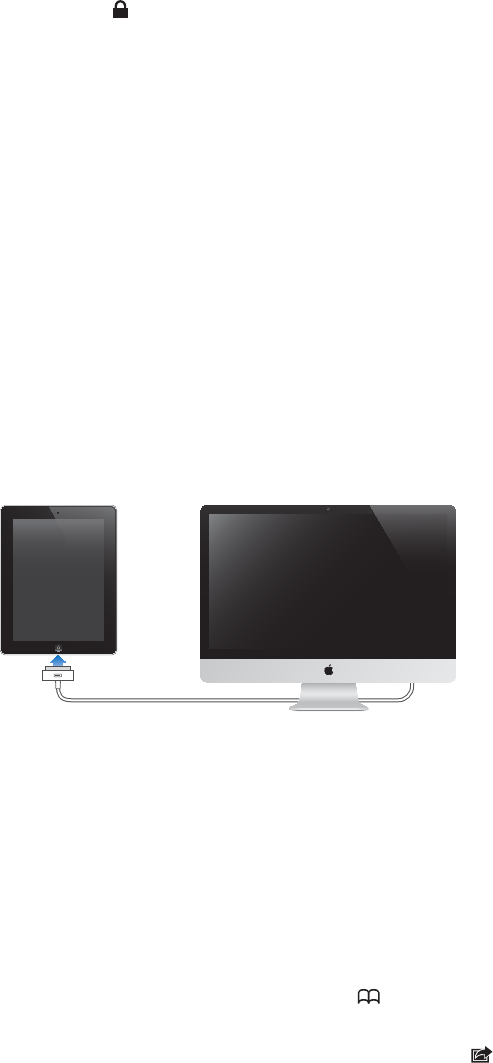
In the device’s Summary pane, select “Encrypt backup” if you want to encrypt the information Â
stored on your computer when iTunes makes a backup. Encrypted backups are indicated by
a lock icon , and you need a password to restore the backup. If you don’t select this option,
passwords (such as those for mail accounts) aren’t included in the backup and have to be
reentered if you use the backup to restore iPad.
In the device’s Info pane, when you sync mail accounts, only the settings are transferred from Â
your computer to iPad. Changes you make to a mail account on iPad don’t aect the account
on your computer.
In the device’s Info pane, click Advanced to select options that let you Âreplace the information
on iPad with the information from your computer during the next sync.
If you listen to part of a podcast or audiobook, your stopping point is included if you sync the Â
content with iTunes. If you started listening on iPad, you can pick up where you left o in iTunes
on your computer—or vice versa.
In the device’s Photo pane, you can sync photos and videos from a folder on your computer. Â
Connecting iPad to your computer
Use the included Dock Connector to USB Cable to connect iPad to your computer. Connecting
iPad to your computer allows you to sync information, music, and other content with iTunes. You
can also sync with iTunes wirelessly. See “Syncing with iTunes.”
Unless iPad is syncing with your computer, you can disconnect it at any time. If you disconnect
while a sync is in progress, some data may not get synced until the next time you connect iPad to
your computer.
Cancel a sync: Drag the slider on iPad.
Viewing the user guide on iPad
You can view the iPad User Guide on iPad in Safari, or you can install the free iBooks app and
download the guide from the iBookstore.
View the user guide in Safari: In Safari, tap , then tap the iPad User Guide bookmark. Or go to
help.apple.com/ipad.
Add an icon for the user guide to the Home screen: Tap , then tap “Add to Home Screen.”
View the user guide in iBooks: If you haven’t installed iBooks, open the App Store, then search
for and install “iBooks.” Open iBooks and tap Store. Search for “iPad User Guide,” then select and
download the user guide.
21
Chapter 2 Getting Started
Draft
Apple Confidential
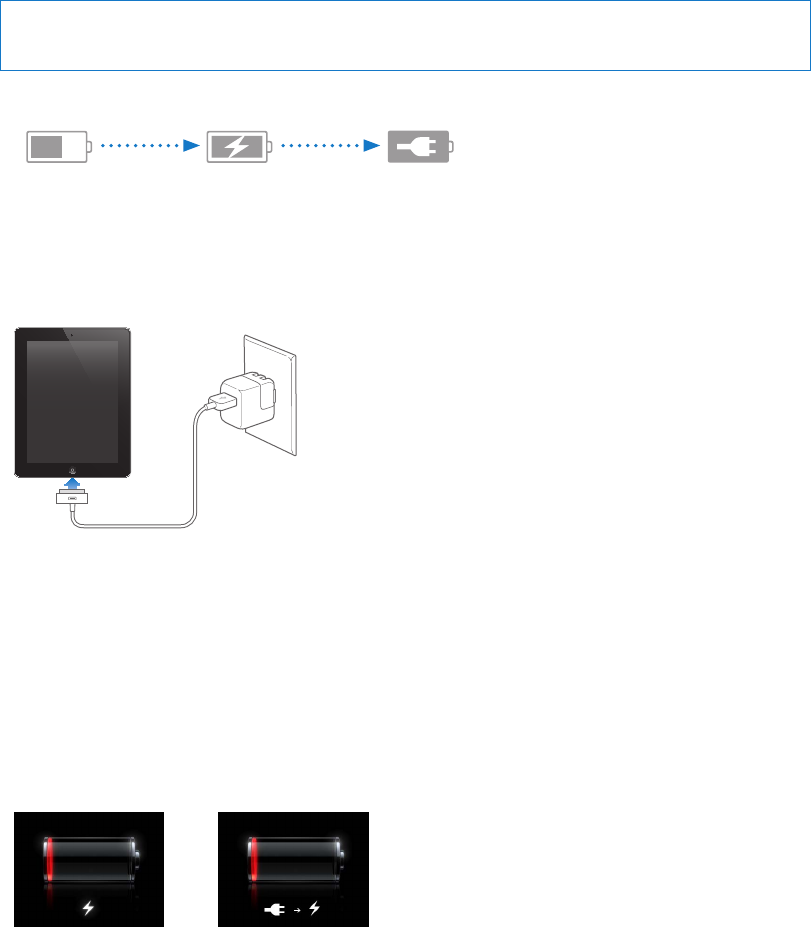
Battery
iPad has an internal rechargeable battery. For more information about iPad batteries, go to
www.apple.com/batteries/ipad.html.
Charging the battery
WARNING: For important safety information about charging iPad, see the iPad Important Product
Information Guide at support.apple.com/manuals/ipad.
The battery icon in the upper-right corner of the status bar shows the battery level or charging status.
Charging
Charging
Not Charging
Not Charging
Charged
Charged
Charge the battery: The best way to charge the iPad battery is to connect iPad to a power outlet
using the included Dock Connector to USB Cable and 10W USB power adapter. When you connect
iPad to a USB 2.0 port on a Mac with the Dock Connector to USB Cable, iPad may charge slowly
while syncing.
Important: The iPad battery may drain instead of charge if iPad is connected to a PC, to a computer
that’s turned o or is in sleep or standby mode, to a USB hub, or to the USB port on a keyboard.
If your Mac or PC doesn’t provide enough power to charge iPad, a “Not Charging” message
appears in the status bar. To charge iPad, disconnect it from your computer and connect it to a
power outlet using the included Dock Connector to USB Cable and 10W USB power adapter.
Important: If iPad is very low on power, it may display one of the following images, indicating that
iPad needs to charge for up to twenty minutes before you can use it. If iPad is extremely low on
power, the display may be blank for up to two minutes before one of the low-battery images appears.
or
or
Maximizing battery life
iPad uses a lithium-ion battery. For information about maximizing the battery life of iPad, go to
www.apple.com/batteries/ipad.html.
Replacing the battery
The iPad battery isn’t user replaceable; it can be replaced only by an Apple Authorized Service
Provider (AASP). Rechargeable batteries have a limited number of charge cycles and may
eventually need to be replaced. AASPs also recycle iPad batteries according to local laws and
regulations. For information, go to www.apple.com/batteries/replacements.html.
22 Chapter 2 Getting Started
Draft
Apple Confidential